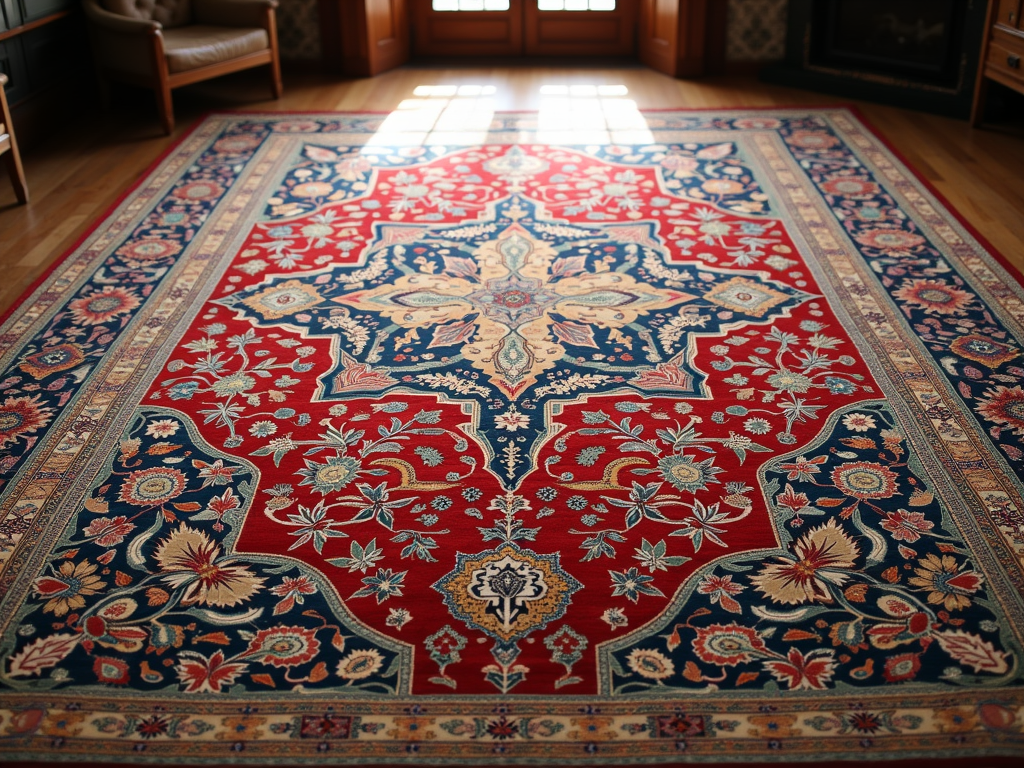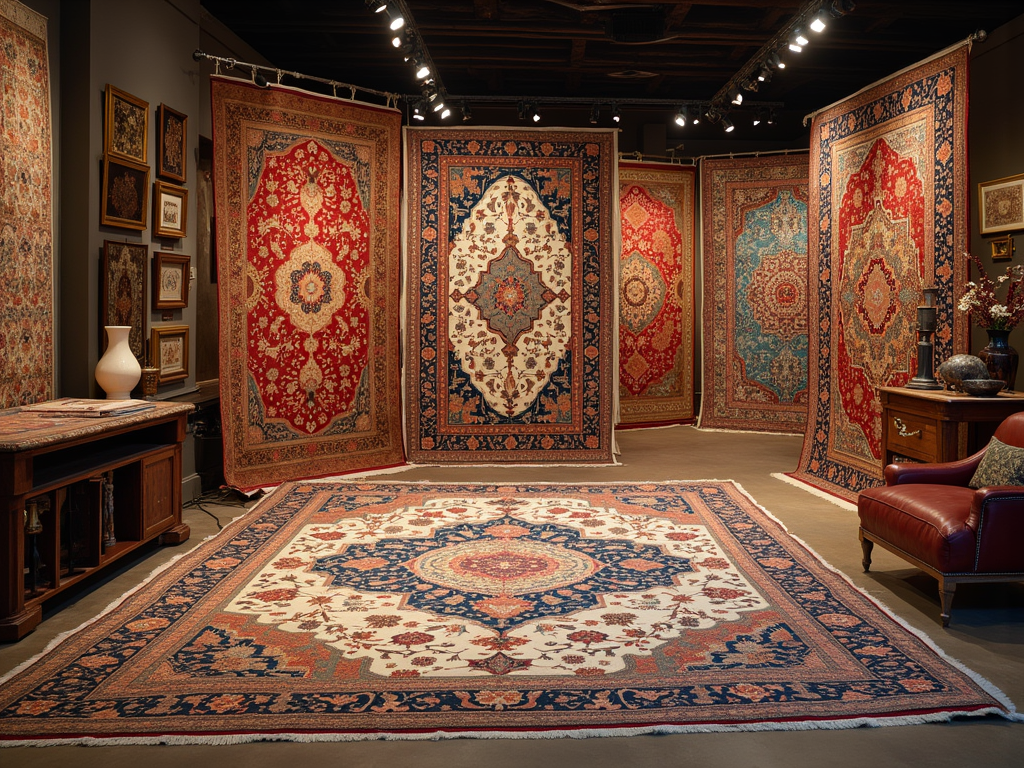
Key Takeaways
- Expert Craftsmanship: Persian rugs showcase expert craftsmanship through dense knot work, often exceeding 1,000 knots per square inch, creating sharp detail and precision.
- Rich Colors: Lasting colors emerge from natural dye sources like madder root and indigo plants, with hues that deepen and enrich over time.
- Symbolic Patterns: Each region’s distinctive patterns and motifs tell stories of cultural heritage and spiritual beliefs.
- Premium Materials: High-grade wool from Iranian mountain sheep and pure silk create superior texture and durability.
- Historic Value: Historic workshop pieces hold the greatest value, with century-old rugs representing the pinnacle of the market.
The Ancient Art That Shaped Global Trade Routes
Origins in Ancient Persia
Persian rugs have captured the imagination of art collectors and interior designers for millennia. These masterpieces originated in ancient Persia (modern-day Iran) over 2,500 years ago in the Persian Empire, establishing themselves as prized possessions across civilizations. The oldest discovered Persian rug, the Pazyryk carpet from the 5th century BCE, measures an impressive 6 by 6.5 feet and stands as testimony to the advanced weaving techniques of ancient Persian artisans.
Ancient Persian rug makers developed unique weaving methods that set their creations apart. Their techniques combined intricate knot work with stunning geometric patterns and natural dyes, creating pieces that would last for generations.
The Golden Age of Persian Rugs
The Safavid Dynasty (1501-1736) marked a turning point in Persian rug-making history. Under the visionary leadership of Shah Abbas I, the industry transformed from small-scale nomadic production into a sophisticated, court-sponsored craft. I’ve found that this period proved crucial in establishing Persian rugs as luxury items sought after by collectors worldwide.
Shah Abbas I’s establishment of royal factories revolutionized production methods and quality standards. These workshops brought together the finest master rug weavers and artisans, creating an environment where creativity flourished and techniques were refined. The rugs produced during this era featured:
- Intricate floral patterns inspired by palace gardens
- Complex geometric designs representing Islamic architecture
- Rich color palettes derived from natural dyes
- Superior wool quality from local sheep
- Silk highlights in premium pieces
The industry continued to thrive under subsequent dynasties, including the Seljuk and Qajar periods. Each era added its unique artistic elements while maintaining the exceptional craftsmanship that made Persian rugs world-famous. These carpets became more than floor coverings – they represented artistic achievement, cultural heritage, and economic power.
Islamic cultural influence played a significant role in the development of Persian rug designs, incorporating meaningful symbols and patterns that told stories through their intricate motifs. The distinction between Persian rugs and other types became increasingly clear, as demonstrated by their superior craftsmanship and artistic merit. Today, you can spot the difference between Persian rugs and standard area rugs through their unique characteristics and unmatched quality.
Why These Rugs Command Million-Dollar Price Tags
Persian rugs represent the pinnacle of textile artistry, with ancient rug-making traditions setting the standard for excellence. The most valuable pieces come from historic workshops, where master rug artisans created masterpieces that have stood the test of time.
Key Factors Determining Value
Age plays a crucial role in a Persian rug’s worth, with antique pieces over 100 years old commanding the highest prices. The market values these older rugs particularly because they showcase traditional techniques and patterns that aren’t replicated in modern production.
Several elements contribute to determining a Persian rug’s market value:
- Knot density (KPSI – knots per square inch) – Premium rugs feature an incredible 1000+ KPSI, while high-quality pieces maintain 300+ KPSI. Good-quality rugs typically range from 80-150 KPSI.
- Materials used – The finest rugs incorporate premium silk and high-grade wool, often colored with natural dyes.
- Size and proportions – Larger rugs with balanced dimensions can fetch higher prices.
- Overall condition – Well-preserved rugs maintain their value better than damaged ones.
- Historical significance – Pieces from notable Persian workshops carry additional prestige.
The rarity of certain designs and patterns can significantly boost a rug’s value. Some antique pieces feature motifs that aren’t found in modern productions, making them highly sought after by collectors. These distinctive traditional Persian patterns often tell stories through their intricate designs.
The cultural significance of these rugs can’t be overlooked. Religious and cultural connections add another layer of value, particularly for pieces with sacred or historically significant patterns. The exceptional craftsmanship and artistic merit of Persian rugs continue to drive their value in the global auction market, where the finest examples regularly sell for millions of dollars.

The Secret Behind Their Unmatched Quality
Premium Materials That Stand The Test of Time
Persian rugs showcase exceptional quality starting with their foundation – the materials. I’ve found that authentic pieces use wool from select sheep breeds, particularly those raised in Iran’s mountainous regions. These sheep produce wool with unique characteristics: longer fibers, higher lanolin content, and better durability. The most exquisite Persian rugs differ from standard area rugs by incorporating pure silk or wool-silk blends, creating an incredible sheen and softness that’s impossible to replicate with synthetic materials.
Master Craftsmanship and Traditional Techniques
The distinguished reputation of Persian rugs stems from their incredible construction methods. As a skilled rug artisan creates each piece, they employ one of two traditional knotting techniques. The asymmetrical Persian knot (Senneh) allows for more intricate patterns and finer details, while the symmetrical Turkish knot (Ghiordes) creates sturdy, durable rugs perfect for high-traffic areas.
The magic doesn’t stop at construction – the colors in Persian rugs tell their own story of excellence. Traditional artisans use natural dyes extracted from organic sources, creating rich, lasting hues that synthetic alternatives can’t match. Here are the key natural dye sources that give Persian rugs their signature colors:
- Madder root provides deep, warm reds that mellow beautifully with age
- Indigo plants create striking blues ranging from sky to midnight
- Pomegranate rinds yield golden yellows and soft browns
- Walnut shells produce rich earth tones
- Larkspur flowers generate vibrant purples
These natural dyes penetrate the wool fibers completely, ensuring the colors remain vivid for generations. This dedication to traditional dyeing methods is one reason why Iran remains world-renowned for rug making. The superior color retention of these natural dyes means Persian rugs often look better with age, developing a sought-after patina that enhances their value over time.
Decoding the Symbolic Language of Persian Rugs
Persian rugs tell stories through their intricate designs and symbols, with each pattern holding deep cultural significance. As a collector of authentic Persian rugs, I’ve learned that these masterpieces aren’t just floor coverings – they’re visual poetry woven into fabric.
Regional Patterns and Their Meanings
The distinctive patterns of Persian rugs vary dramatically by region, creating a rich tapestry of artistic expression. I’ve found that Persian rug artisans develop their unique style based on local traditions and influences. Traditional rug-making techniques have been passed down through generations, with each region maintaining its signature style.
Here are the key regional patterns you’ll encounter:
- Tabriz rugs showcase precise geometric patterns and architectural designs
- Isfahan pieces feature elegant floral motifs and intricate arabesques
- Qashqai rugs display bold tribal patterns and nomadic influences
The symbolic language of these rugs goes deeper through specific motifs. The Herati pattern, often called the “fish pattern,” represents fertility and abundance. The Boteh (paisley) design symbolizes a flaming cypress tree – an ancient symbol of life and eternity. Shah Abbasi flowers, named after Shah Abbas the Great, represent the golden age of Persian art.
Colors play an equally important role in the symbolism. Red tones dominate many Persian rugs, symbolizing wealth, joy, and courage. Green holds special significance as the color of paradise and hope, while blue represents solitude and truth. Religious significance often influences these color choices.
The tree of life pattern stands out as one of the most meaningful designs. This iconic motif represents eternal life and the connection between heaven and earth. You’ll often find it central to prayer rugs and more elaborate pieces. Ancient rug makers used this symbol to express their spiritual beliefs and connection to nature.
Many skilled Persian rug artisans still create these traditional patterns today, though each piece carries the unique fingerprint of its maker. The medallion design, featuring a central geometric shape with radiating patterns, remains particularly popular and showcases the perfect balance between artistic expression and mathematical precision.

Regional Masterpieces That Define Persian Rug Art
Persian Rug-Making Districts and Their Signature Styles
Persian rugs have captured the imagination of art lovers and collectors for generations. As a skilled rug artisan tradition, the craft varies significantly across Iran’s major weaving centers, each adding its own artistic fingerprint to these masterpieces.
In Tabriz, master weavers create rugs with intricate medallion patterns and curvilinear designs. The city’s historical position as a major trade hub on the Silk Road has influenced its distinctive style, which often features precise, detailed motifs and a rich color palette dominated by ruby reds and deep blues.
The artisans of Isfahan specialize in producing exceptionally fine rugs with high knot counts. Their creations showcase elaborate floral patterns and central medallions executed with mathematical precision. These pieces reflect the city’s rich architectural heritage and historical rug-making legacy.
Kerman’s rug makers are famous for their large-scale pieces with intricate all-over patterns. They often incorporate softer color schemes and detailed botanical designs. The region’s weavers frequently use a special weaving technique that creates a particularly dense and durable carpet.
Kashan holds a special place in Persian rug making history. The area’s artisans craft pieces known for their exceptional quality and sophisticated designs, often featuring central medallions surrounded by intricate floral patterns in jewel-toned colors.
The nomadic Qashqai tribe produces rugs with bold geometric patterns and vibrant colors. Their pieces stand out for their distinctive tribal motifs and symbols, telling stories through traditional designs passed down through generations. These rugs often feature diamond shapes, stylized animals, and angular patterns that reflect their nomadic heritage.
Nain’s weavers create some of the most delicate and finely detailed rugs in Iran. Their work typically includes:
- Extremely high knot counts reaching up to 700 knots per square inch
- Subtle color palettes dominated by ivory, blue, and beige
- Intricate floral and arabesque patterns
- Fine wool combined with silk highlights
These regional variations directly impact both value and collectibility. Persian rug collectors and enthusiasts often seek specific regional pieces to complete their collections. The unique characteristics of each region’s rugs make them particularly valuable to those who appreciate their distinct artistic traditions.
The spiritual significance of these masterpieces can’t be overlooked, as they’ve played a central role in Islamic cultural practices throughout history. Many designs incorporate religious symbolism and traditional motifs that carry deep cultural meaning.
Each region’s distinctive style is maintained by dedicated rug making specialists who preserve centuries-old techniques while adapting to modern demands. These master craftspeople ensure that their region’s unique artistic heritage continues to thrive, making Persian rugs some of the most sought-after pieces in the global art market.

Sources:
CarpetVista
Nazmiyal Antique Rugs
Little-Persia
Woven Treasures
The Spruce
